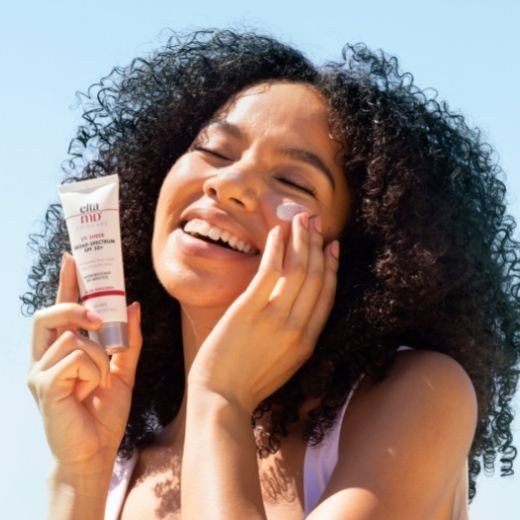7 Common Questions About Sunscreen, Answered
Posted by Nikki Wisher on May 24th 2022
If there’s one piece of advice that every dermatologist will tell every patient ever, it’s to wear sunscreen. As much as our bodies crave spending time outdoors and breathing in fresh air, the sun’s radiation has damaging effects that can accelerate your skin’s aging in addition to potentially causing skin cancer…and giving you the supreme discomfort of a sunburn to boot.
If you’re trying to do the responsible thing, though, you might find yourself unsure of how to do it properly. Between confusing lingo on sunscreen labels to how and when to use your sunscreen, I’m tackling all your top questions about sunscreen.
1. What Does SPF Really Mean?
SPF stands for “sun protection factor,” and it’s not just a random number that correlates to “the higher, the better.” SPF refers to the fraction of the sun’s radiation that gets through the sunscreen’s barrier. If you see a sunscreen with a 20 SPF, it means 1/20 of the sun’s radiation will reach your skin, and for a sunscreen with a 50 SPF, only 1/50 of the sun’s radiation gets through. Generally, an SPF of 30 or higher will give you adequate protection.
2. What Is Broad-Spectrum Sunscreen and Why Is It Necessary?
You might not know that the sun releases multiple types of radiation. The two primary types are UVA and UVB radiation. In short, broad-spectrum sunscreen is designed to block both these types of rays.
Why does that matter? UVA and UVB rays cause different types of sun damage. But they’re both problematic. UVA rays are mostly responsible for prematurely aging your skin, though they also contribute to skin cancer. UVB rays, on the other hand, are mostly responsible for skin cancer and sunburns. With broad-spectrum sunscreen, you can keep all the effects of sun damage at bay with one product.
3. What’s the Difference Between Mineral Sunscreens and Chemical Sunscreens?
Mineral sunscreens and chemical sunscreens use two different methods to block solar radiation. Mineral sunscreens are also known as physical sunscreens. They use two minerals, zinc oxide and titanium oxide, which sit on the surface of your skin to physically block the sun’s rays.
Chemical sunscreens, on the other hand, use specific chemicals that absorb the sun’s rays. This keeps the radiation from reaching the deep layers of your skin where it can cause damage.
You may notice that mineral sunscreens are more expensive than most chemical sunscreens, but they have distinct advantages. There is evidence that some chemicals in chemical sunscreens pose health risks, while mineral sunscreens don’t carry these concerns. Chemical sunscreens can also be irritating to sensitive skin, so if your skin gets red easily, mineral sunscreen would be a safer choice.
4. How Can I Use Sunscreen with a White Cast Left Behind?
A common complaint with sunscreen is that it tends to leave behind a white cast – a layer on your skin that makes you look a bit like a walking zombie, let’s be honest. There are a few ways to get around that.
For one, you could use your sunscreen and then apply makeup on top of it to cover the white coloration. The other option is to look for a sheer sunscreen . These miracle products are formulated to give you great protection without that eerie white cast.
5. Will I Get a Vitamin D Deficiency from Wearing Sunscreen?
Rest assured that when you use sunscreen daily, you aren’t trading one health risk (skin cancer) for another (vitamin D deficiency). The vast majority of us still get enough sun exposure that our bodies can produce plenty of vitamin D, just from the sunlight that gets through our sunscreen in small amounts throughout the day. Typically, the only people who are at risk for a vitamin D deficiency are those who live in climates where they can rarely go outside and those who have medical conditions that require them to go to extreme lengths in their sun protection.
6. Do I Really Have to Reapply My Sunscreen?
I know, I know, it can be annoying, but yes, you really do need to reapply your sunscreen regularly if you want to maintain good sun protection. It’s usually best to apply about every two hours, though each sunscreen’s packaging will tell you more specifically.
If you want to make this more convenient, the new EltaMD UV Stick is a game-changer. It’s a simple stick of sunscreen you can stash in your purse, gym bag, desk, or wherever so you can reapply with a few swipes easily throughout the day.
7. How Can I Make My Sunscreen More Effective?
If you want to give your sunscreen a boost to make it as effective as possible, there are a few things you can do to help it along. First of all, make sure to apply your sunscreen about 15-20 minutes before you head outside because it takes some time for it to become effective.
You can also add an extra layer of protection with your clothing and accessories. This spring and summer, find a wide-brimmed hat you love and rock that hat often to keep more sun off your face. Sunglasses with large lenses are on-trend right now, and they’re fantastic for keeping the sun away from the particularly vulnerable skin around your eyes. You can also wear clothes with a tight weave that provide more coverage like long pants and long-sleeved shirts but be smart about it – heatstroke is a more serious and emergent concern than sun damage.
Putting Your Sunscreen to Good Use
Sunscreen is one of the best things you can do for your skin, and once you’ve incorporated it into your daily routine, it’s incredibly simple and easy. Now that you have all the knowledge you need, pick up some great sunscreens and treat your skin to sun safety.

